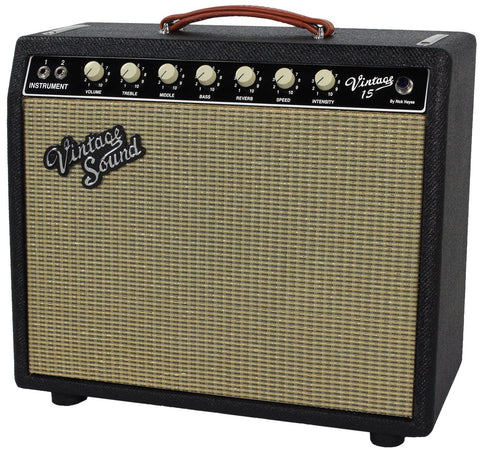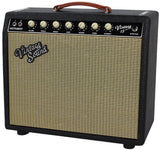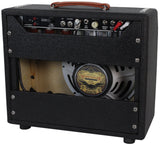The Vintage Sound Vintage 15 is essentially an all handwired, all USA made, modified Princeton Reverb. It's based on the blackface Princeton Reverb (AA1164 circuit) used from 1964-1967, but with several major and significant upgrades.
The Vintage 15 has a decent amount of warm, clean headroom for a 15 watt amp. As you turn the volume knob, it doesn't start breaking up until about 4 or 5 on the dial. It will easily hold it's own again any typical Deluxe Reverb out there. Players from all genres love this amp - from Blues, to Country, to Rock.
Vintage 15 Specifications:
Wattage: 15 watts (or 12 watts with 5Y3 Rectifier)
Preamp Tubes: 3 x 12AX7, 1 X 12AT7
Power Tubes: 2 x 6V6
Rectifier: 1 x 5AR4
Front Controls: Volume, Treble, Middle, Bass, Reverb, Speed, & Intensity.
Rear Controls: Dwell (for controlling the reverb decay time)
Effects: Large Pan, Tube Driven Spring Reverb, Tube Vibrato
Speaker: WGS G12C/S - 1 x 12"
Inputs: 2 Inputs
Auxiliary Input: RCA Footswitch Jack
Extension Speaker Jack: External Speaker Jack
Circuit Construction: All Point-to-Point, Hand-wired
Cabinet Construction: Dove-tail jointed solid pine w/Baltic Birch Plywood baffle and back panels
Pilot Light: Blue Amp Jewel
Combo Dimensions: 17
" High x 19 7/8" Wide x 9 1/2" Deep (32 lbs)
A note about the original Princeton Reverb
A very good question we get asked from time to time is why all the upgrades? Didn't Leo Fender get it right back then? The answer to that is, "well, yes and no." We'll elaborate...
So, while the PR circuit is a fabulous one, let's not forget what was going on with Fender back then. The company had already been around a number of years and in 1964 it was being prepped to sell to CBS (which happened January of 1965). The Princeton Reverb was a student amp, and never was meant to be a major player among gigging or recording musicians. It was a practice amp with reverb. In order to make it a successful model financially, it had to be mass produced as cheaply as possible. Now, with that said, everything was built better back then. We didn't have printed circuit boards or cheap foreign labor to construct amps from, so even the "cheap stuff" was actually pretty darn decent. Still, it was mass produced to hit a price point. That meant leaving bells and whistles out of the design as much as possible. As luck would have it, the amp sounded great, and it has stood the test of time all these years. Because of this, it's very appealing to have a "decked out" version with all these great bells and whistles. Enter the Vintage 15!
Why are we using the 12" WGS G12C/S speakers?
First, we'll address the size... You would be VERY hard pressed to find someone who prefers a 10" speaker in a Princeton Reverb over a 12". If Fender could go back, you could just about bet the farm they would have used a 12" speaker. It provides everything the 10 gives you, but with more mid and bottom end. We have never known anyone who went back to a 10" after modding their Fender Princeton Reverb.
Anyway, we chose the WGS G12C/S for several reasons. The G12C/S is essentially their take on the Jensen C12n, but with several refinements, such as a smoother top end, more touch sensitivity, and an overall warmer tone. The Princeton Reverb circuit can be quite sharp and trebly, particularly when distorted. The G12C/S addresses this very well with it's more rounded top end which is very noticeable on bright guitars like a Telecaster, etc. Furthermore, Warehouse Guitar Speakers are made here in the USA and not in China like most of today's Celestions. Added bonus!
This speaker works great with lower wattage amps in allowing a bit more clean headroom. When driven hard, the breakup you'll get with the Vintage Sound 15 will be all tube saturated overdrive and not distortion from the speaker. This speaker is based on the popular G12C, but with a smooth cone, felt dust cap, and just the right amount of edge treatment.
Many people feel the WGS G12C/S is the perfect speaker for a Princeton Reverb circuit amp. We absolutely agree!
What are the differences between the Vintage 15 and 20?
The Vintage 20 is precisely the same as the Vintage 15 with the following exceptions:
1) The 20 has larger power and output transformers, bringing the output to 20 watts yielding noticeably more clean headroom.
2) As well, the Vintage 20 can alternate between 6V6 and 6L6 power tubes. Overall, the 6V6 tubes are recommended. The 6L6 tubes will deliver slightly more bass, but will be a bit more stiff in response. Stiffness isn't a bad thing if that's what you are going after, but the majority of people will prefer the slightly softer response of the 6V6 tubes. Naturally, your mileage may vary.









